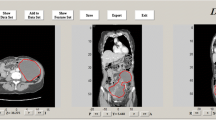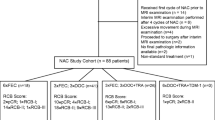Abstract
Purpose
To assess the associations between inter-site texture heterogeneity parameters derived from computed tomography (CT), survival, and BRCA mutation status in women with high-grade serous ovarian cancer (HGSOC).
Materials and methods
Retrospective study of 88 HGSOC patients undergoing CT and BRCA mutation status testing prior to primary cytoreductive surgery. Associations between texture metrics—namely inter-site cluster variance (SCV), inter-site cluster prominence (SCP), inter-site cluster entropy (SE)—and overall survival (OS), progression-free survival (PFS) as well as BRCA mutation status were assessed.
Results
Higher inter-site cluster variance (SCV) was associated with lower PFS (p = 0.006) and OS (p = 0.003). Higher inter-site cluster prominence (SCP) was associated with lower PFS (p = 0.02) and higher inter-site cluster entropy (SE) correlated with lower OS (p = 0.01). Higher values of all three metrics were significantly associated with lower complete surgical resection status in BRCA-negative patients (SE p = 0.039, SCV p = 0.006, SCP p = 0.02), but not in BRCA-positive patients (SE p = 0.7, SCV p = 0.91, SCP p = 0.67). None of the metrics were able to distinguish between BRCA mutation carrier and non-mutation carrier.
Conclusion
The assessment of tumoral heterogeneity in the era of personalized medicine is important, as increased heterogeneity has been associated with distinct genomic abnormalities and worse patient outcomes. A radiomics approach using standard-of-care CT scans might have a clinical impact by offering a non-invasive tool to predict outcome and therefore improving treatment effectiveness. However, it was not able to assess BRCA mutation status in women with HGSOC.




Similar content being viewed by others
References
Siegel RL, Miller KD, Jemal A (2017) Cancer statistics, 2017. CA 67:7–30
Prat J, FIGO Committee on Gynecologic Oncology (2014) Staging classification for cancer of the ovary, fallopian tube, and peritoneum. Int J Gynaecol Obstet 124:1–5
Bolton KL, Chenevix-Trench G, Goh C, et al. (2012) Association between BRCA1 and BRCA2 mutations and survival in women with invasive epithelial ovarian cancer. JAMA 307:382–390
Hyman DM, Zhou Q, Iasonos A, et al. (2012) Improved survival for BRCA2-associated serous ovarian cancer compared with both BRCA-negative and BRCA1-associated serous ovarian cancer. Cancer 118:3703–3709
Petrillo M, Marchetti C, De Leo R, et al. (2017) BRCA mutational status, initial disease presentation, and clinical outcome in high-grade serous advanced ovarian cancer: a multicenter study. Am J Obstet Gynecol 217:334.e1–334.e9
Parsons DW, Jones S, Zhang X, et al. (2008) An integrated genomic analysis of human glioblastoma multiforme. Science 321:1807–1812
Varela I, Tarpey P, Raine K, et al. (2011) Exome sequencing identifies frequent mutation of the SWI/SNF complex gene PBRM1 in renal carcinoma. Nature 469:539–542
Bailey P, Chang DK, Nones K, et al. (2016) Genomic analyses identify molecular subtypes of pancreatic cancer. Nature 531:47–52
Network TCGAR (2011) Integrated genomic analyses of ovarian carcinoma. Nature 474:609–615
Campbell PJ, Yachida S, Mudie LJ, et al. (2010) The patterns and dynamics of genomic instability in metastatic pancreatic cancer. Nature 467:1109–1113
Gerlinger M, Rowan AJ, Horswell S, et al. (2012) Intratumor heterogeneity and branched evolution revealed by multiregion sequencing. N Engl J Med 366:883–892
Gillies RJ, Kinahan PE, Hricak H (2016) Radiomics: images are more than pictures, they are data. Radiology 278:563–577
Nougaret S, Lakhman Y, Gonen M, et al. (2017) High-grade serous ovarian cancer: associations between BRCA mutation status, CT imaging phenotypes, and clinical outcomes. Radiology 285:472–481
Gilks CB, Ionescu DN, Kalloger SE, et al. (2008) Tumor cell type can be reproducibly diagnosed and is of independent prognostic significance in patients with maximally debulked ovarian carcinoma. Hum Pathol 39:1239–1251
Soslow RA (2008) Histologic subtypes of ovarian carcinoma. Int J Gynecol Pathol 27(2):161–174
Reyes MC, Arnold AG, Kauff ND, Levine DA, Soslow RA (2014) Invasion patterns of metastatic high-grade serous carcinoma of ovary or fallopian tube associated with BRCA deficiency. Mod Pathol 27:1405–1411
Yushkevich PA, Piven J, Hazlett HC, et al. (2006) User-guided 3D active contour segmentation of anatomical structures: significantly improved efficiency and reliability. Neuroimage 31:1116–1128
Haralick RM, Shanmugam K (1973) Textural features for image classification. Systems. IEEE Trans Syst Man Cybern 6:610–621
Vargas HA, Veeraraghavan H, Micco M, et al. (2017) A novel representation of inter-site tumour heterogeneity from pre-treatment computed tomography textures classifies ovarian cancers by clinical outcome. Eur Radiol 38:1–11
Eisenhauer EA, Therasse P, Bogaerts J, et al. (2009) New response evaluation criteria in solid tumours: revised RECIST guideline (version 11). Eur J Cancer 45:228–247
Rustin GJ, Marples M, Nelstrop AE, Mahmoudi M, Meyer T (2001) Use of CA-125 to define progression of ovarian cancer in patients with persistently elevated levels. J Clin Oncol 19:4054–4057
Safra T, Lai WC, Borgato L, et al. (2013) BRCA mutations and outcome in epithelial ovarian cancer (EOC): experience in ethnically diverse groups. Ann Oncol 24:viii63–viii68
Sun C, Li N, Ding D, et al. (2014) The role of BRCA status on the prognosis of patients with epithelial ovarian cancer: a systematic review of the literature with a meta-analysis. PLoS ONE 9:e95285
Funding
All authors received funding from the National Cancer Institute (P30 CA008748). Andreas Meier received funding from the Professor Dr Max Cloëtta Foundation.
Author information
Authors and Affiliations
Corresponding author
Ethics declarations
Conflict of interest
The authors declare that they have no conflict of interest.
Ethical approval
All procedures performed in studies involving human participants were in accordance with the ethical standards of the institutional and/or national research committee and with the 1964 Helsinki declaration and its later amendments or comparable ethical standards. This article does not contain any studies with animals performed by any of the authors.
Electronic supplementary material
Below is the link to the electronic supplementary material.
Rights and permissions
About this article
Cite this article
Meier, A., Veeraraghavan, H., Nougaret, S. et al. Association between CT-texture-derived tumor heterogeneity, outcomes, and BRCA mutation status in patients with high-grade serous ovarian cancer. Abdom Radiol 44, 2040–2047 (2019). https://doi.org/10.1007/s00261-018-1840-5
Published:
Issue Date:
DOI: https://doi.org/10.1007/s00261-018-1840-5




